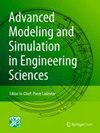利用断裂动力学理论对非对称应变控制疲劳行为进行周动态数值研究
IF 3.2
Q3 MECHANICS
Advanced Modeling and Simulation in Engineering Sciences
Pub Date : 2024-05-13
DOI:10.1186/s40323-024-00264-4
引用次数: 0
摘要
数值疲劳过程建模非常复杂,目前仍是一项尚未完成的任务。由疲劳裂纹引起的不连续需要基于附加参数的特殊有限元技术,这些参数的选择对模拟结果有很大影响。此外,根据经验材料系数(如巴黎定律)计算疲劳寿命并不能解释这一过程,系数应根据实验测试设定,但这并不总是可能的。20 年前提出的一种没有坐标空间导数的新的非局部连续介质力学公式,即周动力学(PD),为疲劳裂纹等非连续性建模提供了新的机会。使用基于原子论方法的断裂动力学理论(KTF)可以更好地描述疲劳过程,该理论在其微分疲劳损伤方程中包含了过程温度、最大和最小应力以及加载频率。本研究对标准 316L 不锈钢试样进行测试,然后运行 KTF-PD 疲劳模拟。根据材料的 S-N 曲线校准的内部 MATLAB 代码用于 KTF-PD 模拟。提出并应用了基于循环应力-应变滞后环的新型 KTF 方程来预测疲劳寿命。模拟结果与实验结果进行了比较,发现在对称和非对称循环加载情况下模拟结果与实验结果一致。本文章由计算机程序翻译,如有差异,请以英文原文为准。
Peridynamic numerical investigation of asymmetric strain-controlled fatigue behaviour using the kinetic theory of fracture
Numerical fatigue process modelling is complex and still an open task. Discontinuity caused by fatigue cracks requires special finite element techniques based on additional parameters, the selection of which has a strong effect on the simulation results. Moreover, the calculation of fatigue life according to empirical material coefficients (e.g., Paris law) does not explain the process, and coefficients should be set from experimental testing, which is not always possible. A new nonlocal continuum mechanics formulation without spatial derivative of coordinates, namely, peridynamics (PD), which was created 20 y ago, provides new opportunities for modelling discontinuities, such as fatigue cracks. The fatigue process can be better described by using the atomistic approach-based kinetic theory of fracture (KTF), which includes the process temperature, maximum and minimum stresses, and loading frequency in its differential fatigue damage equation. Standard 316L stainless steel specimens are tested, and then the KTF-PD fatigue simulation is run in this study. In-house MATLAB code, calibrated from the material S‒N curve, is used for the KTF-PD simulation. A novel KTF equation based on the cycle stress‒strain hysteresis loop is proposed and applied to predict fatigue life. The simulation results are compared with the experimental results, and good agreement is observed for both symmetric and asymmetric cyclic loading.
求助全文
通过发布文献求助,成功后即可免费获取论文全文。
去求助
来源期刊

Advanced Modeling and Simulation in Engineering Sciences
Engineering-Engineering (miscellaneous)
CiteScore
6.80
自引率
0.00%
发文量
22
审稿时长
30 weeks
期刊介绍:
The research topics addressed by Advanced Modeling and Simulation in Engineering Sciences (AMSES) cover the vast domain of the advanced modeling and simulation of materials, processes and structures governed by the laws of mechanics. The emphasis is on advanced and innovative modeling approaches and numerical strategies. The main objective is to describe the actual physics of large mechanical systems with complicated geometries as accurately as possible using complex, highly nonlinear and coupled multiphysics and multiscale models, and then to carry out simulations with these complex models as rapidly as possible. In other words, this research revolves around efficient numerical modeling along with model verification and validation. Therefore, the corresponding papers deal with advanced modeling and simulation, efficient optimization, inverse analysis, data-driven computation and simulation-based control. These challenging issues require multidisciplinary efforts – particularly in modeling, numerical analysis and computer science – which are treated in this journal.
 求助内容:
求助内容: 应助结果提醒方式:
应助结果提醒方式:


